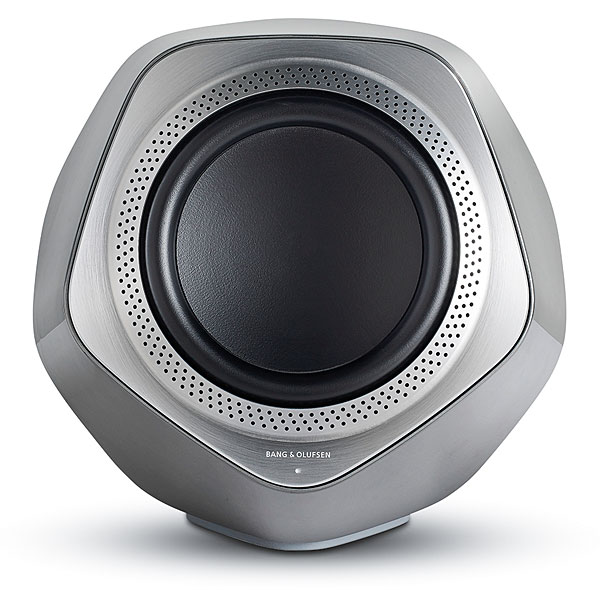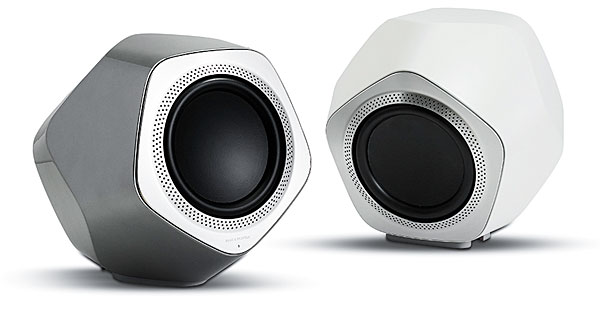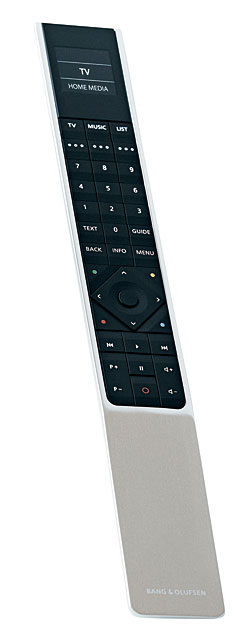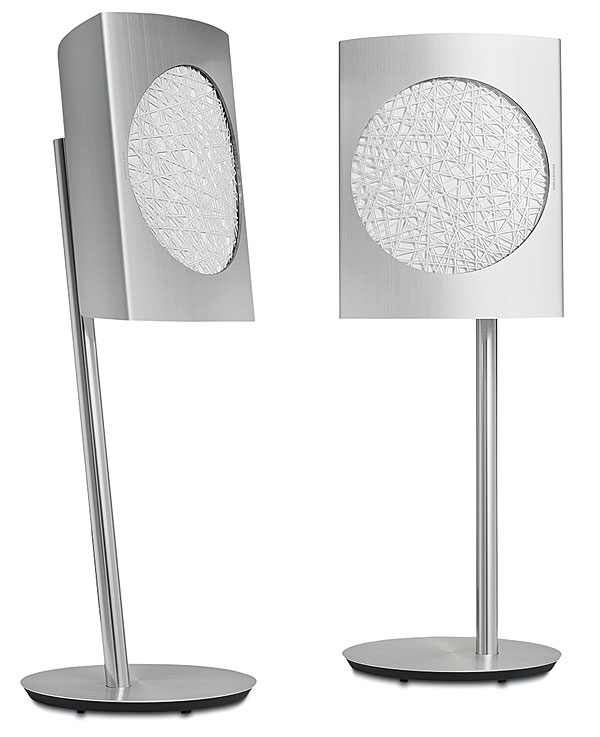Bang & Olufsen BeoVision Avant 55 Ultra HDTV and BeoLab 18 Wireless Speaker System Review Page 2

Then there’s the world’s first WiSA-certified subwoofer. Most people try to hide their sub, or at least minimize its presence. With the BeoLab 19, it’s a different story. I can tell you that the exterior is made of a highly polished composite material with an anodized aluminum faceplate that surrounds the woofer; otherwise, I’ll let B&O describe the sub. The company calls it a “12-sided polyhedron” or “dodecahedron, derived from the Greek for twelve and faces.” The design was chosen for “both its sculptural identity and its structural integrity. This singular shape comprises 12 regular pentagons, three of which meet at every vertex to provide exceptional rigidity.” (I couldn’t have said it better myself, which is why I didn’t try to.)

The $3,395 BeoLab 19 incorporates two 8-inch woofers, each with a dedicated 160-watt Class D amp. The woofers are mounted in separate back-to-back enclosures to minimize physical interaction between the two drivers. In addition to standard phase and low-pass switches, thermal protection, and B&O’s Adaptive Bass Linearization (ABL) to prevent overdriving, the subwoofer uses the company’s Acoustic Balance Principle, which operates the opposing drivers in phase electrically to take advantage of equal but opposite forces to cancel undesirable vibrations. It features both RCA and PowerLink connections as well as the wireless link.
Living the High Life
So what’s it like living with a $25,000 Bang & Olufsen system? Is it worth the hype, or has B&O hyped its worth?
 To answer that, let’s start with what I consider to be the weakest part of the system: the BeoRemote One. In addition to everything else the BeoVision Avant 55 TV does, it’s a universal remote repeater system—or it can be when you use the BeoRemote One. When you connect a new source to the Avant 55, the TV will ask a variety of setup questions, including whether or not you’d like the TV to control its operation. If yes, you download the proper set of control codes from B&O through the TV and affix a wired IR blaster over the IR receiver window of the new component. In my case, the BeoRemote One/Avant 55 combo controlled my Apple TV and Panasonic Blu-ray player without a hitch.
To answer that, let’s start with what I consider to be the weakest part of the system: the BeoRemote One. In addition to everything else the BeoVision Avant 55 TV does, it’s a universal remote repeater system—or it can be when you use the BeoRemote One. When you connect a new source to the Avant 55, the TV will ask a variety of setup questions, including whether or not you’d like the TV to control its operation. If yes, you download the proper set of control codes from B&O through the TV and affix a wired IR blaster over the IR receiver window of the new component. In my case, the BeoRemote One/Avant 55 combo controlled my Apple TV and Panasonic Blu-ray player without a hitch.
Milled from a single piece of aluminum, with inset black buttons and a small LED window display near the top, the BeoRemote One is gorgeous and feels wonderful in your hand. The button caps are small, with even smaller labels, which isn’t a problem in a bright room, but the BeoRemote One isn’t backlit. Watch a movie in a darkened room, and you’ll never find the right button without twisting and turning and waiting for a bright scene in the movie to see what you’re doing. In all fairness to B&O, you can operate everything through onscreen menus—if you can find the menu button on the remote in the dark. There’s also a basic remote app for iOS and Android tablets (smartphone versions are pending).
Magic and More Magic
The optional ($2,095) motorized floor stand for the BeoVision Avant 55, on the other hand, is to die for. At first glance, it’s an unadorned circular aluminum (of course) 26-inch-diameter base with a 2.5-inch-diameter, 35-inch-tall offset post that holds the TV. It certainly looks good when the TV is off. Turn the TV on, though, and as the internal speakers emerge slowly, the stand begins to move the TV majestically along two axes of rotation to a user-programmed position. The base of the stand rotates, revolving the offset post that rotates on its own axis as well; although it can’t continue past 360 degrees in either direction because of the power cable and any source or IR interconnects running through it.
There’s more to this than the coolness factor, however. It’s quite a useful feature. For example, if you want to listen to two-channel music, you can program the stand to swivel/pivot the TV until it’s as far behind the BeoLab 18s as possible. For movies, it might move to a front-and-center position. For news or talk shows, you can program it to move and angle itself to a position that’s perfect for viewing from a seating location off to the side of the room—or from an adjoining open kitchen or recreation area. You can also manually adjust the position of the TV/stand combo using the BeoRemote One.
By the way, when you first turn on the TV, something else happens in addition to the magic of the TV speakers dropping down and the stand moving the TV to the correct position: Black bars on the screen gradually pull back from the center to reveal the image on the screen, in much the same way that stage curtains are pulled apart at a theater before a performance. Oh, and a hair-thin sliver of light under the acoustic lens on each BeoLab 18 briefly illuminates to let you know the speakers are on. (Hidden LEDs on the BeoLab 17s and BeoLab 19 also light up.) Details, details.
Now, is any of this motorization or visual wizardry absolutely necessary? Of course not. But it subtly creates anticipation and excitement before the music or movie begins, which invariably make listening or watching much more enjoyable.
The Tonmeister Says…
When it comes to sound quality, you wouldn’t expect a system like this to intimidate your senses with sheer power. While there’s certainly something to be said for huge subwoofers and deep, wood-veneered cabinets in terms of pressurizing the room (and impressing friends), the BeoLab speakers (along with the Avant 55 TV for movies) never threaten to drive you from the room, even at very significant volume levels. In fact, the opposite is true. The soundfield pulls you into it.

By chance, I’d come across an old disc with several Holly Cole Trio songs on it. “Calling You” is a favorite because it’s an emotional, simple rendition that contrasts deep piano notes with Cole’s higher-octave vocals, while the upright bass embraces both. Despite the fact that the BeoLab 18 consists of only that pair of 4-inch woofers and a top-mounted tweeter, the sound here was incredibly smooth and rich throughout the frequency range. Of course, the BeoLab 19 subwoofer was an absolute necessity to give strength and depth to the lowest output of the piano and bass, but the match of speakers and sub was superb.
I also played the Tonmeister’s suggested disc, featuring the debut recording of Arvo Pärt’s Te Deum, with Tõnu Kaljuste conducting the Estonian Philharmonic Chamber Choir and the Tallinn Chamber Orchestra. It showed off the beautifully light and airy openness and wide dispersion of the BeoLab 18s’ tweeters, with their acoustic lenses. Not only that, but the clarity and detail of the quietest passages proved without a doubt that the WiSA technology is clearly capable of audiophile performance.
I’ve not yet heard the entirety of Transformers: Age of Extinction on a Dolby Atmos system. After watching this surprisingly entertaining movie with the non-Atmos B&O Avant 55 TV and BeoLab speaker system, I’m not sure how it could sound any better. The BeoLab 18s and 17s worked as one unit, a testament to both the impressive acoustics of the BeoLab speakers and the lack of any unwanted delay from the WiSA wireless transmission. I noticed this same wonderful cohesion when I watched Ender’s Game, especially during the training simulations at Command School. The BeoLab 19, by the way, turned into an absolute bass machine during much of the movie. Overall, the system gave an impeccable performance.

It was even a treat to use the Avant 55 with its integrated three-channel speaker system as the front speakers, supported only by the BeoLab 19 sub and the BeoLab 17s in the rear. Of course, the front soundstage wasn’t nearly as wide as that of the system with the BeoLab 18s, but it was really astounding how well the “TV speaker system” performed. When I listened to the Avant 55 as LCR (versus the Avant speakers functioning as center channel only with the BeoLab 18s handling left and right channels), the sound narrowed down in the front, giving the effect of a triangular soundfield. That said, if you’re someone who doesn’t want separate front speakers, this is the best TV-based package I’ve ever heard.
Conclusion
As I mentioned earlier, for the $25,000 that this system costs, you could buy a car. And, as does the B&O system, that car will move (unless you’re really bad at buying cars). Both, as a matter of fact, will move you, although in totally different ways. My Prius, for example, does a fine job of getting me to and from the grocery store. Bang & Olufsen’s BeoVision Avant 55 Ultra HDTV with the surrounding BeoLab 18, 17, and 19 WiSA-certified speakers, on the other hand, won’t get me anywhere near my local grocery. But the B&O system will give me a thrill every time I fire it up (something that no grocery has ever done). More important, it’ll take you on a virtual trip to any grocery—such as the one with ransacked aisles roamed by the living dead in Zombieland or the staid suburban outlet that gets a rapid inventory reduction thanks to Angelina Jolie and her bag of high-tech ballistics in Wanted—and make it more exciting and entertaining than almost any other system could. To paraphrase an old BASF tag line: Bang & Olufsen doesn’t make the movies. They just make them better—so much so that it’s hard to put a price on it.





























































